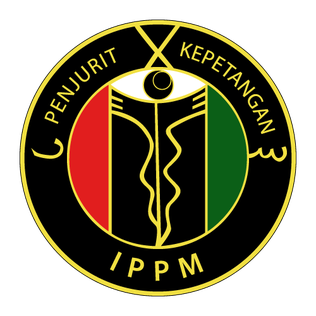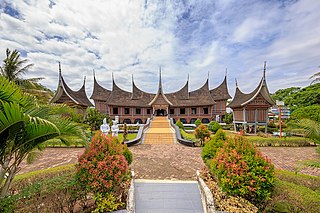Related Research Articles

Minangkabau people, also known as Minang, are an Austronesian ethnic group native to the Minangkabau Highlands of West Sumatra, Indonesia. The Minangkabau's West Sumatran homelands was the seat of the Pagaruyung Kingdom, believed by early historians to have been the cradle of the Malay race, and the location of the Padri War.

West Sumatra is a province of Indonesia. It is located on the west coast of the island of Sumatra and includes the Mentawai Islands off that coast. The province has an area of 42,119.54 km2 (16,262.45 sq mi), with a population of 5,534,472 at the 2020 census. The official estimate at mid 2022 was 5,640,629. West Sumatra borders the Indian Ocean to the west, as well as the provinces of North Sumatra to the north, Riau to the northeast, Jambi to the southeast, and Bengkulu to the south. The province is subdivided into twelve regencies and seven cities. It has relatively more cities than other provinces outside of Java, although several of them are relatively low in population compared with cities elsewhere in Indonesia. Padang is the province's capital and largest city.

Pagaruyung, also known as Pagarruyung, Pagar Ruyung and, Malayapura or Malayupura, was a kingdom that once stood in the island of Sumatra and the seat of the Minangkabau kings of Western Sumatra. Modern Pagaruyung is a village in Tanjung Emas subdistrict, Tanah Datar regency, located near the town of Batusangkar, Indonesia.

Adityawarman was a king of Malayapura Suvarnabhumi, and is the successor of the Mauli dynasty based on central Sumatra. He was the cousin of Jayanegara, king of Majapahit from 1309 to 1328, and the grandson of Tribhuwanaraja, king of Melayu Kingdom. Adityawarman was awarded the Senior Minister of Majapahit (wreddamantri) and used this authority to launch Majapahit military expansion plans and conquered east coast region in Sumatra. Adityawarman then founded the royal dynasty of Minangkabau in Pagaruyung and presided over the central Sumatra region to take control of the gold trade between 1347 and 1375.

The Melayu Kingdom was a classical Buddhist kingdom located in Southeast Asia and western Nusantara.

Tarumanagara or Taruma Kingdom or just Taruma was an early Sundanese Indianised kingdom, located in western Java, whose 5th-century ruler, Purnawarman, produced the earliest known inscriptions in Java, which are estimated to date from around 450 CE.

Kantoli was an ancient kingdom suspected to be located somewhere between Jambi and Palembang in southern Sumatra around the 5th century of the common era. The Sanskrit name for this polity is Kuntala. Chinese records indicate that "Sanfotsi was formerly called Kantoli" and this as well as the location of the kingdom have led historians to consider Kantoli as the predecessor of Srivijaya. Srivijaya was referred to as Sanfotsi by the Chinese.

The Overseas Minangkabau is a demographic group of Minangkabau people of Minangkabau Highlands origin in Central Sumatra, Indonesia who have settled in other parts of the world. Over half of the Minangkabau people can be considered overseas Minangkabaus. They make up the majority of the population of Negeri Sembilan and Pekanbaru. They also form a significant minority in the populations of Jakarta, Bandung, Medan, Batam, Surabaya and Palembang in Indonesia as well as Kuala Lumpur, Malacca, Penang, Singapore and Brunei Darussalam in the rest of the Malay world. Minangkabaus have also emigrated as skilled professionals and merchants to the Netherlands, United States, Saudi Arabia and Australia. The matrilineal culture and economic conditions in West Sumatra have made the Minangkabau people one of the most mobile ethnic group in Maritime Southeast Asia.

The Sultanate of Siak Sri Indrapura, often called Sultanate of Siak, was a kingdom that was located in the Siak Regency, Riau from 1722 to 1949. It was founded by Raja Kechil, who was from the Johor Kingdom, after he failed to seize the throne of the Sultanate of Johor. The polity expanded in the 18th century to encompass much of eastern Sumatra as it brought various communities under its control through warfare and control of trade between the interior of Sumatra and the Melaka Straits. The Dutch colonial state signed a series of treaties with Siak rulers in the 19th century, which reduced the area of state influence to the Siak River. For the remainder of the Dutch colonial era, it operated as an independent state with Dutch advisors. After Indonesia's Independence was proclaimed on 17 August 1945, the last sultan of Siak declared his kingdom to join the Republic of Indonesia.

Istiadat Pewaris Penjurit-Kepetangan Melayu or formerly known as Ilmu Persilatan Penjurit-Kepetangan Melayu, shortform IPPM is one of the oldest original known to date Malay martial art form or called 'Silat' in existence which has been heritage from one generation to another. Descended from the first ruler of the Malayapura Kingdom, King Adityawarman whom is also known as Seri Maharaja Diraja which to a later stage sparked the start of Minangkabau history in Pagaruyung Kingdom, Sumatra, Indonesia. These story has been greatly narrated in most of old Malay Literature including in of the most reliable sources to date called Sulalatus al-Salatin or better known as The Malay Annals (Malay: Sejarah Melayu). The manuscript begin with the stories of Wan Malini and Wan Empuk whom was presented with 3 adopted princes right after when their rice fields was magically expelling gold. These 3 princes was later mark as the kickstart for the next 3 big empires in Malay Archipelago. Those empires were the Kingdom of Majapahit, The Malacca Sultanate and the Pagaruyung Kingdom around the 12th century.
Dara Jingga, was one of the Malay Dharmasraya princess who was intended to be betrothed to Javanese King Kertanegara of Singasari after the Pamalayu expedition 1275–1293.
Isyana stylized as Sri Isyana Tunggawijaya was a queen regnant of Mataram Kingdom, in East Java, that ruled since 947 CE. She co-reigned with her spouse, Sri Lokapala. The Isyana dynasty, established by her father, Mpu Sindok that ruled Java circa the 10th century CE, was named after her.
Sri Makutawangsa Wardhana was the king of Mataram Kingdom, in East Java, that ruled prior to 990s CE. He was the son and the successor of Queen Isyana Tunggawijaya and King Sri Lokapala. He belongs to the Isyana dynasty, established by his grandfather, Mpu Sindok that ruled Java circa the 10th century CE.

Adityawarman Museum is a State Museum located in Padang, Western Sumatra. As a State Museum, Adityawarman Museum is officially known as the State Museum of West Sumatra. The museum displays ethnographic collections of items related to the culture of the Province of West Sumatra, particularly the culture of Minangkabau and Mentawai.
Adwayawarman was the father of King Adityawarman of Malayapura kingdom as mentioned in the Kuburajo I Inscription. His alias name was Adwayadwaja, as he was called in the Bukit Gombak Inscription.
Bijayendrawarman was the name of one a yuwaraja of the Malayapura kingdom, who ruled in the 14th century in the Pasaman Regency, West Sumatra, Indonesia. Bijayendrawarman's name is written in Lubuk Layang inscription, found in Pancahan village, in Rao Selatan district of Pasaman. It was stated that he built a stupa, in a place called Parwatapuri.
Akarendrawarman was a ruler of Malayapura kingdom in the Minangkabau plateau. His name was found in the Pagaruyung VII inscription, which is written in Old Malay, his full title is Paduka Sri Maharajadhiraja Srimat Sri Akarendrawarman. In carrying out his administration, he was assisted by various other officials, among others was a minister called Tuhan (lord) Parpatih. The kingdom was mentioned to be located in Parhyangan on Mount Mahameru.
Lubuk Layang inscription, also known as Kubu Sutan inscription, is an inscription found in 1970 in Kubu Sutan, Lubuk Layang, Rao Selatan district, Pasaman Regency, of West Sumatra, Indonesia.

Saruaso II inscription, also previously known as Batusangkar inscription, is one of the inscriptions from the King Adityawarman era. It is currently located at the Fort van der Capellen area, in the courtyard of the old office of the Monuments Preservation Department, in Batusangkar city, West Sumatra, Indonesia. The inscription was previously displayed across in front of the Indo Jalito Building, which was the residence of the Regent of Tanah Datar during the Dutch colonial period. The inscription is written in Old Javanese script and Sanskrit language.

Kuburajo Inscription, also called Kuburajo I Inscription, is one of the many inscriptions left by King Adityawarman of central Sumatra. The inscription was found in Kuburajo village, Lima Kaum district, Tanah Datar Regency, West Sumatra, Indonesia in 1877 besides the main road from Batusangkar city to Padang city. The inscription was registered by N.J. Krom in Inventaris der Oudheden in de Padangsche Bovenlanden. The inscription is written in Sanskrit, and consists of 16 lines. This inscription was lost in 1987, but was rediscovered.
References
- 1 2 3 4 5 Andaya, Leonard Y. (2008). Leaves of the Same Tree: Trade and Ethnicity in the Straits of Melaka . ed. berilustrasi. University of Hawaii Press. pp. 87–88. ISBN 0-8248-3189-6.
- 1 2 Schnitger, F. M. (1937). The Archaeology of Hindoo Sumatra. Leiden: Brill Archive. p. 13.
- 1 2 Prasetyo, Deni (2009). Mengenal Kerajaan-Kerajaan Nusantara. Pustaka Widyatama. p. 53. ISBN 9796103095.
- ↑ Kozok, Uli (2015). A 14th Century Malay Code of Laws: The Nitisarasamuccaya. Vol. 16 dari Nalanda-Sriwijaya Series. Institute of Southeast Asian Studies. p. 39. ISBN 9814459747.
- ↑ Poesponegoro, Marwati Djoened; Notosusanto, Nugroho (2008). Sejarah Nasional Indonesia: Zaman Kuno. Vol. 2 dari Sejarah nasional Indonesia. PT Balai Pustaka. p. 108. ISBN 9794074101.
- 1 2 3 Reichle, Natasha (2007). Violence and Serenity: Late Buddhist Sculpture from Indonesia. ed. berilustrasi. University of Hawaii Press. p. 139. ISBN 0-8248-2924-7.